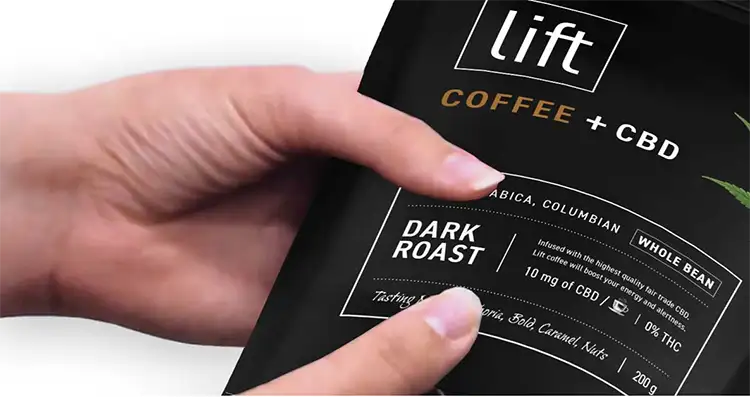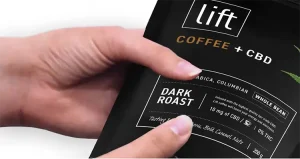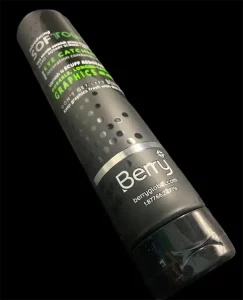
By Kim Guarnaccia, Huzzah Marketing

An elegant matte appearance with a rich, suede-like feel, soft-touch finishes have become popular over the last decade with print and packaging designers and are now applied to a wide range of substrates, from paperboard and plastics to even aluminum.
For luxury, high-end brands, a soft-touch finish serves to emphasize their premium appeal. For other companies, soft touch makes the unboxing experience memorable, protects packaging against damage in high-traffic environments, and even helps increase sales.
But to complicate things, there are numerous ways to achieve a soft-touch effect, from lamination to coatings and even Cast and Cure™. Below is a summary of each of these processes.
Laminates
One of the most durable ways to achieve a soft-touch feel on a printed piece or packaging is to laminate board with a matte, biaxially oriented polypropylene (BoPP) film that offers a soft-touch surface during the finishing process.
Soft-touch laminates are commonly applied just after printing offset or digitally to add haptic (tactile) value. They also are compatible with other embellishment technologies, add scuff resistance and rigidity to a package’s structure, and will not impede a package from being diecut, stamped, spot-varnished or overprinted.
However, there are a few challenges to consider. Since soft-touch laminates will cause a slight shift in color, they tend to make printed inks appear more muted. Moreover, the plasticized film can make packaging more difficult to recycle, albeit modern recycling facilities, especially those in metropolitan areas, can accept laminated paper and board into their processing streams.
In terms of cost, soft-touch laminates tend to be a bit pricy. This is sometimes offset, however, by less expensive operational costs.
Coatings

The most common way to apply soft touch is via a specialty coating. Since soft-touch coatings do not require an extra press pass and often can be applied inline on press, it’s usually more cost-effective than a laminate. And provided that the coating is water-based or UV-cured, it will not affect the recyclability of the underlying substrate. Nor will it mute the color of any printed inks.
Moreover, since soft-touch coatings do not appreciably add to the overall structure thickness, it can accept folding, scoring, diecutting, embossing, overprinting and stamping. And by using different anilox rollers or a screen mesh, coatings can be applied heavily or lightly, depending on the amount of soft touch desired.
However, since coatings are difficult to deliver via inkjet, they are best applied via screen printing or flexography.
Cast and Cure
Unlike most soft-touch coatings, Cast and Cure™ (Breit-Tech.com) can be applied inline and is a standard feature on many digital, flexo and offset presses. This, combined with the fact that the Cast-and-Cure film can be reused up to a dozen times, makes this application one of the least expensive and most sustainable soft-touch options in the marketplace.
With the Cast-and-Cure process, a UV varnish is applied, after which a special film is “cast,” or overlaid, embedding a special matte effect into the varnish. The varnish is then UV-cured and the used film rolled onto a new core, so it can be reused. Finally, a specially formulated soft-touch ink is applied to the UV-cured varnish.
Since the process is essentially a simple application of a UV varnish and overprinted ink, this finish can be applied to just about any substrate, from paperboard, flexible cartons, plastics, labels and aluminum. And like coatings, Cast-and-Cure soft touch can be applied heavily or lightly, depending on how much of a soft-touch feel is desired.
Since varnish and ink is recyclable, the Cast-and-Cure soft touch application will not affect the recyclability or compostability of a substrate. Nor will it impede any specialty effects, such as embossing/debossing, folding/creasing or spot varnishing.
Author’s note: My grateful appreciation to Kevin Camblin of UV Specialties (uvspecialties.com); Laura Blake of Nobelus (nobelus.com); and Dan Plash of Breit Technologies (breit-tech.com) for generously providing input in their areas of expertise.
An appreciator of packaging that utilizes colorful special effects, Kim Guarnaccia provides copywriting, design and marketing to the print, packaging and paper multiverse. For more info, visit www.HuzzahLLC.com or email kim@HuzzahLLC.com.

